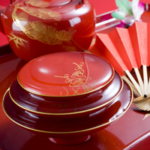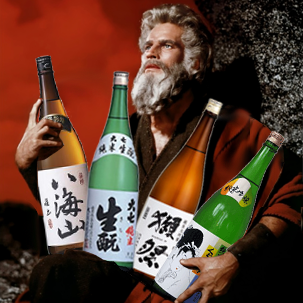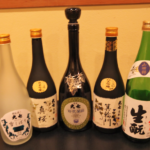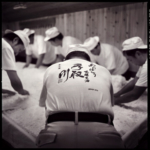The 10 Commandments of Sake
 Well, good heavens! I’ve been teaching about sake since 2007 and believe me, I get it – sake can be confusing and even downright intimidating for those just getting started.
Well, good heavens! I’ve been teaching about sake since 2007 and believe me, I get it – sake can be confusing and even downright intimidating for those just getting started.
I always thought it would be a good idea to pull together a cheat sheet of core concepts to help everyone understand more about sake basics. Thus was born the 10 Commandments of Sake, my guide to get your bearings and to start enjoying the wonderful world of sake. Can I get an “Amen” in here?
Ⅰ. Sake is Japanese Culture in a Cup.
 Right off the bat it’s important to understand that Sake is deeply connected to Japanese culture. I call it “Japanese Culture in a Cup.” Sake is known in Japan as the “drink of the gods” and it has deep ties to both religion, ceremony, traditions and everyday social interaction. Get to know sake, and you’ll get to know Japan. Like so much in Japanese culture, on the surface, sake may seem simple, restrained or perhaps even plain, but dig a little deeper and you’ll discover a vast and colorful world of styles, tastes, methods and lore – and a devoted group of acolytes, committed to the quiet pursuit of perfection.
Right off the bat it’s important to understand that Sake is deeply connected to Japanese culture. I call it “Japanese Culture in a Cup.” Sake is known in Japan as the “drink of the gods” and it has deep ties to both religion, ceremony, traditions and everyday social interaction. Get to know sake, and you’ll get to know Japan. Like so much in Japanese culture, on the surface, sake may seem simple, restrained or perhaps even plain, but dig a little deeper and you’ll discover a vast and colorful world of styles, tastes, methods and lore – and a devoted group of acolytes, committed to the quiet pursuit of perfection.
Ⅱ. Thou Shalt Pair Sake With More Than Just Sushi.
 For better or for worse, America’s omnipresent sushi restaurants are the place where almost all of us get our first exposure to sake. This has lead some to conclude that sake should only be served with raw fish. In reality, nothing could be further from the truth. Sake pairs beautifully with a stunningly wide array of cuisines and dishes. Some of the top restaurants in the world have sake on their wine lists. Give premium sake a try with any of your favorite dishes – Roast Beef, Pizza or even Thanksgiving Dinner… There is a sake you can pair up with any of these. Experiment and enjoy!
For better or for worse, America’s omnipresent sushi restaurants are the place where almost all of us get our first exposure to sake. This has lead some to conclude that sake should only be served with raw fish. In reality, nothing could be further from the truth. Sake pairs beautifully with a stunningly wide array of cuisines and dishes. Some of the top restaurants in the world have sake on their wine lists. Give premium sake a try with any of your favorite dishes – Roast Beef, Pizza or even Thanksgiving Dinner… There is a sake you can pair up with any of these. Experiment and enjoy!
Ⅲ. Thou Shalt Not Even Think About Calling Sake a ‘Rice Wine’.
Ok, I’ll admit it, this is not the biggest sin in the book, but it is a major pet peeve of mine, so I’m gonna get up on my soapbox. Sometimes people want to dumb down sake for the masses and rely on the crutch of calling sake a “rice wine”. Blasphemy I say. If you get out the dictionary and actually look up the definition of wine, it says a wine is alcoholic drink made from the fermented juice of a fruit, such as grapes. Rice is not a fruit nor is it a plant that can produce juice. So, rice cannot produce wine. The finished product may drink like a wine, or even be served in a wine glass, but I think sake is important enough to merit it’s own category in the beverage world.
Ⅳ. Thou Shalt Not Bomb nor Shoot.
I feel that the Sake Bomb and Sake Shot are unfortunate vestiges of what I’ll call an unenlightened medieval period in the history of sake in the States. For the uninitiated, Sake Bombs involve dropping a small cup of cheap sake into a beer and drinking both quickly and Sake Shots involve slamming back an entire small cup of sake in one swift gulp. Both of these behaviors are now most likely seen during get-me-drunk-quick shenanigans during college, but in the wider world, we are happily moving well beyond the image of the sake bomb. More and more people recognize premium sakes as true artisinal works of art with craftspeople devoting their lives to its production and betterment. So leave the Sake Middle Ages behind and join us in the Sake Renaissance. Oh, and if someone asks you to do a sake bomb, do what Mr. T and Nancy Reagan recommend – “Just Say NO!”
Ⅴ. Thou Shalt Avoid Heat and Light When Storing Sake.
 Heat and light are the enemies of sake. If you want extend the shelf life of your sake, keep it in a cool, dark place. If you have room in there, the refrigerator is the obvious choice! Pasteurized sake does not need to be refrigerated, but it is always a better option if you’re able. Please note that those yummy unpasteurized “nama” sakes must be refrigerated at all times. Oh, and don’t patronize that liquor shop that put all their sake on display in the front window. That’s literally not cool.
Heat and light are the enemies of sake. If you want extend the shelf life of your sake, keep it in a cool, dark place. If you have room in there, the refrigerator is the obvious choice! Pasteurized sake does not need to be refrigerated, but it is always a better option if you’re able. Please note that those yummy unpasteurized “nama” sakes must be refrigerated at all times. Oh, and don’t patronize that liquor shop that put all their sake on display in the front window. That’s literally not cool.
Ⅵ. Thou Must Pay a Premium for Premium.
 It’s worthwhile knowing that cost and quality classifications are attached at the hip in the world of sake. If you want to enjoy an extra special sake with a Daiginjo or Junmai Daiginjo super premium classification, be prepared to pay more. There is not much bargain hunting for undiscovered gems as you may have in the wine world. Rice milling directly effects raw material costs for sakes. As sakes rate higher on the premium classification scale, the rice used to make those sakes is more finely milled and that means raw material costs are going up, too. To be clear, yummy and quality sakes can be had in all classification levels, but the more finely milled sakes most often cost more. Explore and see what style you (and your wallet) like best.
It’s worthwhile knowing that cost and quality classifications are attached at the hip in the world of sake. If you want to enjoy an extra special sake with a Daiginjo or Junmai Daiginjo super premium classification, be prepared to pay more. There is not much bargain hunting for undiscovered gems as you may have in the wine world. Rice milling directly effects raw material costs for sakes. As sakes rate higher on the premium classification scale, the rice used to make those sakes is more finely milled and that means raw material costs are going up, too. To be clear, yummy and quality sakes can be had in all classification levels, but the more finely milled sakes most often cost more. Explore and see what style you (and your wallet) like best.
Ⅶ. Thou Shalt Not Pour For Thyself.
 In Japan, the most basic etiquette rule of serving sake is known as o-shaku. The main tenant of o-shaku is that it is considered most polite to pour sake for others but never directly for yourself. This little ritual of pouring for others creates an atmosphere of social interaction and bonding and the small sake cups typically used in Japan allow for many opportunities for everyone at the table to pour and receive sake. I have often seen a friendly tug of war over a sake carafe as guests jockey to be the first to pour for the other. Be sure to note that when you are receiving sake, it’s viewed as most respectful to lift your cup up off the table, hold it with two hands and be sure to take a sip before setting it back down. Why worry about this here? Well, I think it’s a fun and endearing custom that gets everyone at the table interacting and gets the sake flowing – the perfect way to jump start any sake event!
In Japan, the most basic etiquette rule of serving sake is known as o-shaku. The main tenant of o-shaku is that it is considered most polite to pour sake for others but never directly for yourself. This little ritual of pouring for others creates an atmosphere of social interaction and bonding and the small sake cups typically used in Japan allow for many opportunities for everyone at the table to pour and receive sake. I have often seen a friendly tug of war over a sake carafe as guests jockey to be the first to pour for the other. Be sure to note that when you are receiving sake, it’s viewed as most respectful to lift your cup up off the table, hold it with two hands and be sure to take a sip before setting it back down. Why worry about this here? Well, I think it’s a fun and endearing custom that gets everyone at the table interacting and gets the sake flowing – the perfect way to jump start any sake event!
Ⅷ. Thou Shalt Not Fear the Screw Cap.
Some wine people seem to have a true phobia when it comes to screw caps. They are reputedly the domain of inexpensive, low quality wines. Sake manufacturers, however, have taken a different tack and use screw caps almost exclusively for all bottles, from the bargain basement sakes to the most expensive Junmai Daiginjos. I couldn’t be more thrilled. Screw caps just make sense. They are easy to open, easy to re-seal and do the best job of keeping the sake protected from oxidation. Once you start drinking more sake, you’ll come to much prefer that ‘craaack’ sound of opening a sake screw cap to the crumbly pop of a wine cork, as I have. But please – don’t sniff the screw cap.
Ⅸ. Thou Shalt Experiment With Serving Temperature.
What is the correct serving temperature for sake? Hot? Cold? in between? In a nutshell, there is no strict right and wrong in serving temperature as both warm and chilled sake can be wonderful. It’s all about finding the right sake for the right temperature for your palate. In general, fragrant, floral and aromatic sakes are best for serving slightly chilled as that will enhance their aroma. And again, in general, full bodied, robust and dry sakes tend to be a great choice for warming as that brings forward the alcohol notes on the palate and will suppress aroma. But whatever temperature you pick, it’s good to note that sake is so flexible in this area. You can drink it warm when you come in from shoveling show, or drink it cold to escape the summer heat. Serving temperature is actually sake’s secret weapon in the battle of the alcoholic beverages. Sake 1, other booze 0.
Ⅹ. To Thy Own Palate Be True: Drink Whatever Sakes You Enjoy!
 Last but not least is the true Golden Rule of the sake world, and the easiest sake commandment to follow. Never forget that at its core, sake is about enjoyment and having fun. Be sure to give yourself permission not to worry too much about pairing rules, milling rates or serving temperature. You can simply start out by finding a sake you like and really enjoying it – simple as that. If you want to dive deeper down the road, you can certainly geek out with me about all the classifications and regions and rice types of the sake world, but none of that really matters for sake’s most basic function: to bring people together for having fun. Trust your own likes and drink whichever sakes speak to you regardless of price, reviews or expert recommendations. Simply put: “To thy own palate be true.” Well, hallelujah, I’ll drink to that!
Last but not least is the true Golden Rule of the sake world, and the easiest sake commandment to follow. Never forget that at its core, sake is about enjoyment and having fun. Be sure to give yourself permission not to worry too much about pairing rules, milling rates or serving temperature. You can simply start out by finding a sake you like and really enjoying it – simple as that. If you want to dive deeper down the road, you can certainly geek out with me about all the classifications and regions and rice types of the sake world, but none of that really matters for sake’s most basic function: to bring people together for having fun. Trust your own likes and drink whichever sakes speak to you regardless of price, reviews or expert recommendations. Simply put: “To thy own palate be true.” Well, hallelujah, I’ll drink to that!





